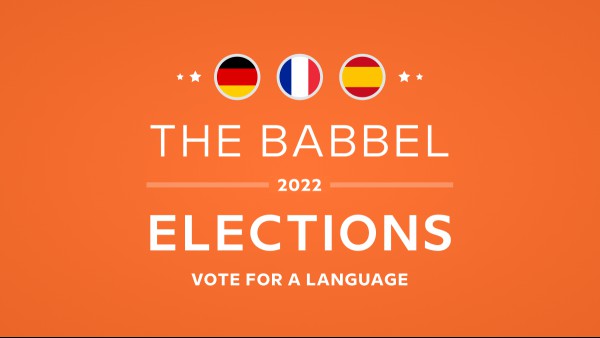German Punctuation Marks And How To Use Them
Punctuation rules are an important part of written language. They help to structure a text in a clear and comprehensible way, to phrase thoughts and information in a way that recipients can easily follow a common thread and understand which parts belong together. While commas and semicolons might not be the first thing you think of when you’re learning a language, they’re an important part. German punctuation may overlap quite a bit with English punctuation, but there are differences that could trip you up.
Here, we compiled the most common uses for German punctuation. Pay special attention to the ways German punctuation is used differently (the commas in particular can be tricky). You’ll be punctuating properly in no time!
The Rules Of German Punctuation
full stop/period . (der Punkt)
A full stop is placed at the end of a sentence. It comes after the last word without a space.
- Der Zug kommt in 20 Minuten. Ich fahre nach Berlin. — The train comes in 20 minutes. I’m going to Berlin.
A full stop is also used to abbreviate words.
- 20 Min. (Minuten) — 20 minutes
- z. B. (zum Beispiel) — for example
- usw. (und so weiter) — et cetera
When you read out a full stop in a URL of a website or in an email address you also use the word Punkt.
- www.babbel.de (www Punkt babbel Punkt de)
comma , (das Komma)
A comma has many different functions in German punctuation. First, it’s used when listing a series of items to separate them from one another. Before und (“and”) or oder (“or”), there is never a comma.
- Ich brauche Salz, Pfeffer, Öl und Zitrone für den Salat. — I need salt, pepper, oil and lemon for the salad.
A comma is also used to separate two main clauses.
- Die Bücher sind im Regal, die Kleidung liegt auf dem Bett. — The books are on the shelf, the clothes lie on the bed.
Note: This is considered a “comma splice” in English, which goes against grammatical rules, but it’s fine in German.
However, the comma is optional with two main clauses when they are connected by coordinating conjunctions like und (“and”), oder (“or”) and wie (“as”). The comma may be used for legibility, however.
- Meine Nachbarin arbeitet im Garten(,) und der Hund schaut ihr gelangweilt zu. — My neighbor is working in the garden(,) and the dog is watching her bored.
In sentences that contain both a main and a subordinate clause, you usually have to use a comma to separate them. There are a lot of different types of subordinate clauses, e.g. relative clauses or subordinate clauses introduced with a subordinating conjunction like weil (“because”), wenn (“if,” “when”), dass (“that”), ob (“whether”), obwohl (“although”), bis (“until”) and many more.
- Sie nimmt die Banane, die auf dem Tisch liegt. — She’s taking the banana, which lies on the table.
- Er fährt mit dem Fahrrad, weil es besser für die Umwelt ist. — He is riding the bike, because it’s better for the environment.
- Ich bin mir sicher, dass sie pünktlich sein werden. — I’m sure that they will be on time.
Another important use of a comma is in letters or emails. In German, a comma is often used in the opening. Heads up! The text that follows in the next line continues with a lowercase letter, unless the first word is a noun.
- Hallo Maria, vielen Dank für deine schnelle Antwort. … — Hello Maria, Thank you so much for your quick response. …
- Sehr geehrte Familie Lustig, wir bestätigen Ihnen hiermit Ihre Hotelreservierung. … — Dear family Lustig, We hereby confirm your hotel booking. …
How does a comma change the meaning of the following sentence?
- Sibel wartet auf ihre Schwester Bea und Musti. — Sibel is waiting for her sister Bea and Musti.
- Sibel wartet auf ihre Schwester, Bea und Musti. — Sibel is waiting for her sister, Bea and Musti.
In the first sentence (without a comma), Sibel is waiting for two people, because Bea is Sibel’s sister. In the second sentence (with a comma), Sibel is waiting for three people: her sister, Bea and Musti.
semicolon ; (das Semikolon)
A semicolon is mainly used when you think that a full stop would be too strong to separate two parts, because they belong closer together but not as close as to use only a comma to separate them. The important thing to remember is that after a semicolon you continue with lowercase letters, unless the word is a noun.
- Gestern war ich im Kino; der Film war sehr spannend. — Yesterday I went to the movies. The movie was very exciting.
In everyday writing it’s a less common punctuation mark though. In most cases a semicolon can be replaced by a full stop. You will encounter a semicolon mainly in longer sentences to break them up a little bit or when several items are listed with commas that belong to different categories.
- Wir brauchen Zucker, Mehl, Milch; Äpfel, Orangen, Birnen; Toilettenpapier, Waschmittel. — We need sugar, flour, milk; apples, oranges, pears; toilet paper, detergent.
exclamation mark ! (das Ausrufezeichen)
The exclamation mark is mainly used with interjections, exclamations, wishes and orders.
- Herzlichen Glückwunsch zum Geburtstag! — Happy Birthday!
Have a look at the following example. How can an exclamation mark change the tone of the sentence?
- Ich gehe. — I’m leaving.
- Ich gehe! — I’m leaving!
The sentence with the full stop is (without any context) more neutral. The exclamation mark, depending on the context, can change the tone of the sentence implying anger, disappointment, sadness, happiness, etc.
question mark ? (das Fragezeichen)
A question mark in German indicates that you need to go up with your voice towards the end of the sentence. It’s used at the end of questions, as well as with single question words. Like with the full stop or the exclamation mark, there is no space between the last word and the question mark.
- Wieso? — Why?
- Hast du heute Abend schon vor? — Do you already have plans for tonight?
In informal speech you can change a declarative sentence to a question by replacing the full stop with a question mark.
- Er kocht. — He is cooking.
- Er kocht? — Is he cooking?
In the first sentence the voice goes down, whereas in the second one the voice goes up, because it’s a question.
colon : (der Doppelpunkt)
A colon introduces a series of items or an explanation. If a full sentence follows the colon, the first letter of the following sentence needs to be capitalized.
- Wir haben endlich gebucht: Es geht nach Italien! — We finally booked: We are traveling to Italy!
- Ich packe in meinen Koffer: einen Pullover, eine Zahnbürste, einen Hut. — I’m packing into my suitcase: a sweater, a toothbrush, a hat.
Note: “Ich packe in meinen Koffer” is a popular children’s game in Germany. In turns, everyone adds another item and the person after needs to remember the ones mentioned before and add another one. So the list of items can become very long. The game ends when one person can’t remember an item or mixes up the order.
A colon is also used to indicate a direct speech.
- Er fragte uns: „Wohin geht ihr?“ — He asked us, “Where are you going?”
Have you noticed where the quotation marks in German are placed? We’ll take a closer look at it now.
quotation marks „ “ (die Anführungszeichen)
Quotation marks in German are unique. The ones at the beginning are at the bottom pointing to the left. The closing ones are at the upper end of the last word point to the right.
They are used for quotations as well as book titles, song titles, movie titles, etc.
- „Phantasie ist wichtiger als Wissen, denn Wissen ist begrenzt.“ ist ein bekanntes Zitat von Einstein. — “Imagination is more important than knowledge, for that knowledge is limited.” is a well-known quote from Einstein.
Also, quotation marks are used to illustrate direct speech.
- Dann sagte sie: „Ich komme nicht mit!“ — Then she said, “I’m not coming!”
The quotation marks enclose everything that belongs to the text of the direct speech, i.e. also the punctuation. Fun Fact: Germans call quotation marks also Gänsefüßchen, which translates to “little geese feet.”
apostrophe “ ‘ “ (ein Apostroph)
An apostrophe is not often used in German. Some people, especially new learners, use it incorrectly after names to express belonging or possession, which is how it’s used in English. In German, you do not use an apostrophe before the genitive s, which is the “s” is added to the name without any punctuation mark.
- Merlins Fahrrad wurde geklaut. — Merlin’s bike was stolen.
However, you need it with names that are ending in s, z, ß or x:
- Max’ Schwester lebt in Marokko. — Max’s sister lives in Morocco.
- Nils’ Brille is neu. — Nils’s glasses are new.
hyphen – (der Bindestrich)
A hyphen is mainly used to separate syllables of a word at the end of a line when a line break happens.
- Satzzeichen helfen uns, Texte besser zu strukturieren und zu verste-
hen. — Punctuation marks help us to better structure and understand texts.
A hyphen is also used to be more efficient when using a language. It can be used to avoid repeating a word.
- Alle Kinder- und Erwachsenenschuhe sind in der ersten Etage. — All children’s and adult’s shoes are on the first level.
Here the hyphen after Kinder- is a replacement for Schuhe. This way the word Schuhe does not need to be used twice. Sometimes it’s advisable to use a hyphen with huge compound noun constructions — not uncommon in German — for better readability:
- Schokoladengeburtstagstorte or Schokoladen-Geburtstagstorte — chocolate birthday cake
dash – (der Gedankenstrich)
A dash is longer than a hyphen. It indicates a pause for thought or speech, often to emphasize what’s coming next.
- Schokoladeneis – meine Lieblingseissorte! — Chocolate ice cream – my favorite ice cream flavor!
It can also be used to “insert” a thought into the bigger sentence. In this case the dash is used as a pair around the insertion.
- Paris – ich liebe diese Stadt – ist immer wieder einen Besuch wert! — Paris – I love this city – is always worth a visit!
The Names Of German Punctuation Marks
Need a quick guide to punctuation marks? Here’s what they’re called in German.
| English | Punctuation | German |
| Period/Full Stop | . | der Punkt |
| Comma | , | das Komma |
| Semicolon | ; | das Semikolon |
| Colon | : | der Doppelpunkt |
| Ellipsis | … | Auslassungspunkte |
| Quotation Marks | „ “ | die Anführungszeichen |
| Apostrophe | ‘ | der Apostroph |
| En Dash | – | der Bindestrich |
| Em Dash | — | der Gedankenstrich |
| Parentheses | ( ) | die Klammern |
| Exclamation Mark | ! | das Ausrufezeichen |
| Question Mark | ? | das Fragezeichen |
We hope this overview helped you to understand the use of German punctuation and that you now feel more confident applying the rules. Have a look at the Babbel app to find more ways to improve your German skills.
Viel Spaß beim Weiterlernen!





